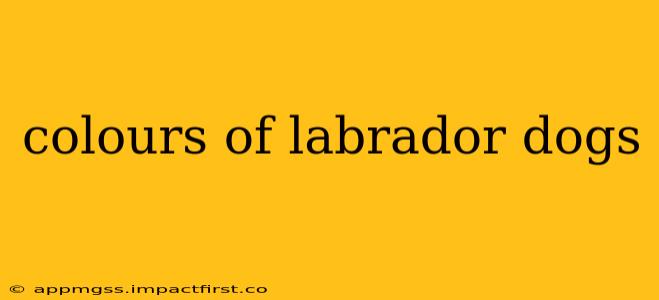Labrador Retrievers, beloved for their friendly nature and playful spirit, boast a captivating range of coat colors. While many think only of the classic yellow, black, and chocolate, the reality is far richer and more nuanced. This comprehensive guide delves into the genetics, variations, and subtleties of Labrador coat colors, answering all your burning questions.
What are the common colors of Labrador Retrievers?
The three most commonly recognized Labrador Retriever colors are black, chocolate (liver), and yellow. However, the shade of each color can vary significantly, leading to a wide spectrum within each category. For example, yellow Labs can range from a light cream to a rich fox-red, while chocolate Labs can appear almost reddish-brown in some instances. This variation is due to the interaction of different genes controlling pigment production.
What causes the different colors in Labrador Retrievers?
The color of a Labrador's coat is determined by the interaction of two primary genes: the B gene and the E gene.
-
The B gene: This gene controls the production of eumelanin, a dark pigment responsible for black and brown coloration. The B gene has two main alleles (variants): B (black) and b (brown). A dog with at least one B allele will have black pigment, while a dog with two b alleles (bb) will have brown (chocolate) pigment.
-
The E gene: This gene controls the distribution of eumelanin and phaeomelanin (a yellow/red pigment). The most important alleles for coat color are E (full expression of both eumelanin and phaeomelanin) and e (restricted expression of eumelanin, leading to yellow coloration). A dog with at least one E allele will express either black or brown pigment depending on its B gene. A dog with two e alleles (ee) will have a yellow coat.
The combination of these genes results in the different coat colors. For instance, a black Lab has at least one B and at least one E allele (BBEE, BbEE, BBEe, or BbEe), while a chocolate Lab has two b alleles and at least one E allele (bbEE, bbEe). A yellow Lab has two e alleles (eeBB, eeBb, or eebb). The intensity of the yellow color is influenced by other modifying genes.
Are there rare Labrador colors?
While black, chocolate, and yellow are the most common, there are some less frequent variations that can arise from unique genetic combinations or even slight mutations. These might include:
- Silver Labs: These Labs exhibit a diluted black coat appearing silver or gray. This dilution is often caused by a recessive gene interacting with the B gene.
- Champagne Labs: Similar to silver Labs, these have a diluted coloration, giving a light, champagne-like appearance.
It's crucial to note that some breeders might promote "rare" colors without thorough genetic testing, potentially contributing to health problems. Responsible breeding always prioritizes the health and well-being of the dogs.
What is the difference between yellow and fox red Labradors?
The difference between yellow and fox-red Labs lies primarily in the intensity of the phaeomelanin pigment. Fox-red Labs possess a much richer, deeper red-toned yellow coat compared to the lighter cream or pale yellow of some yellow Labs. This variation is attributed to modifier genes interacting with the E and potentially the B gene.
Do Labrador coat colors affect their temperament?
No scientific evidence suggests a correlation between a Labrador's coat color and its temperament. Individual personality traits are influenced by various factors, including genetics, socialization, and training. A black Lab can be just as playful and affectionate as a yellow or chocolate Lab.
Can I predict my Labrador puppy's color?
Predicting a Labrador puppy's exact coat color requires understanding the genetics of both parents. If you know the genotypes (the specific alleles) of the parents, you can use Punnett squares to determine the possible genotypes and corresponding phenotypes (colors) of the offspring. However, even with this knowledge, the exact shade within a color category remains uncertain due to modifying genes.
This exploration of Labrador Retriever colors highlights the fascinating complexity of canine genetics. While the classic black, chocolate, and yellow remain the most prevalent, the subtle variations and rarer shades only add to the charm and diversity of this beloved breed. Remember, responsible breeding practices are essential for ensuring the health and well-being of these amazing dogs.
